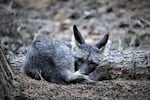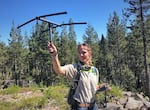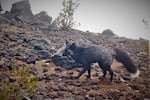At an Oregon Department of Fish & Wildlife office, biologist Jamie Bowles reviewed a video clip submitted to her for species identification. Recorded while driving a forest road in Central Oregon’s Cascade mountains, the handheld video showed a glimpse of gray and black fur as a small animal slipped behind a ponderosa pine.
The animal reappeared and began a slow trot alongside the road. It was an ash-gray color, with tiny black legs, pointy ears tipped with black, and a narrow black muzzle. Clearly it was a canid, but too small to be a coyote. Its puffy tail nearly dragged on the ground and was tipped with white, the signature feature of a fox.
“This is unbelievable,” the driver narrated to the recording phone. “What a beautiful animal. I think it’s one of those Cascade red foxes...”
The driver’s guess made sense. In fact, as recently as a decade ago, wildlife biologists would have concurred.
But Bowles confirmed a different identity of the wild animal in the submitted video. It was the rarest and most endangered red fox subspecies in North America that she’d been tracking for years: the Sierra Nevada red fox.
Jamie Bowles never expected to become one of Oregon’s leading experts in Sierra Nevada red foxes. The field research that Bowles conducted is an important first step in learning about Sierra Nevada red foxes in Oregon.

One of the foxes captured and collared by Jamie Bowles, know as SNFR 14. Bowles is a biologist at the Oregon Department of Fish & Wildlife who become one of Oregon’s leading experts on the endangered and rare Sierra Nevada red fox.
Courtesy of Ashley Vanderstar
Rare foxes discovered in Oregon
Red foxes are one of the world’s most familiar carnivores, living throughout North America, Europe, Asia, and portions of Australia. The ubiquitous red fox is so well known that it has long been a popular character in children’s books, myths and fables — synonymous with guile, stealth, and the origin of common phrases like “outfoxed.”
But Sierra Nevada red foxes are a special type of red fox, not of the lowlands but of the mountains. There are three species of “montane” red foxes, named for their home mountain ranges in the West: Rocky Mountain red foxes, Cascade red foxes, and Sierra Nevada red foxes.
Because the name Sierra Nevada red fox is a mouthful, biologists like Bowles playfully refer to them by their acronym SNRF, pronounced “snurf.”
In the 1800s, trappers discovered that the foxes in the high Sierra had especially soft fur — an ideal commodity for their trade. By the 1970s, the wild mountain foxes had been so extensively hunted that California banned trapping them. Biologists estimated that the isolated populations of the Sierra Nevada red fox had dwindled to a genetically precarious low. In 1980, the population was listed as “threatened” under the California Endangered Species Act.
At that point, the total number of these foxes was thought to be less than 50, living in only two pockets of the Sierras. Conservationists advocated for their protection at the federal level.
Then, in 2010, an unexpected sighting was reported near Mount Hood, several hundred miles north of their known homeland. Another sighting occurred two years later in Oregon’s Central Cascades.
In 2012, Jon Nelson, now curator of wildlife at the High Desert Museum, was conducting undergraduate research on golden eagles near Mount Bachelor. He had set up trail cameras and laid out a deer carcass as bait. To his surprise, his trail cameras captured images of a small fox.
Tim Hiller, executive director and founder of the nonprofit Wildlife Ecology Institute, surveyed the area where Nelson had caught a red fox on his trail cam. The researchers set up “hair snags,” metal bristles that can catch tufts of an animal’s fur as it passes. The hair samples were sent to a university in California for DNA analysis. The results were a game changer: They weren’t Cascade red foxes, but actually Sierra Nevada red foxes.
The Oregon Department of Fish and Wildlife had no idea of their population — not even an estimate. The agency classified them as a ”strategy species,” a category of wild animals with small, declining, or unknown population levels that could be at risk and may be in need of conservation. So little was known about the Sierra Nevada red foxes in Oregon that anything learned was new information and could begin to help fill in what ODFW called “data gaps.”

Wildlife biologist Jamie Bowles uses radio telemetry to track a Sierra Nevada red fox that she previously captured and collared with a radio transmitter. Bowles is a biologist at the Oregon Department of Fish & Wildlife who become one of Oregon’s leading experts on the endangered and rare Sierra Nevada red fox.
Ian McCluskey / OPB
Unexpected fox expert
When she was young, Bowles had always loved animals and dreamed of being a marine biologist. In 2009, while working in the medical industry, Bowles suddenly found herself laid off due to the economic downturn. Both unemployed and pregnant with her third child, Bowles was inspired to make a career change. She entered a master’s program at Oregon State University in natural resource management.
While in the program, she was hired as a wildlife technician for ODFW. Bowles was able to combine her master’s project with ODFW’s research needs for Sierra Nevada red foxes.
Bowles set out on a mission to find out where the foxes lived in the Central Cascades, where they roamed, and any other observations she could make about them.
Trapping had led to their near demise, yet to study them Bowles would have to become a trapper herself. She acquired spring-loaded box traps built for bobcats and set out to learn all she could.
To bring the foxes to her traps, she experimented with an assortment of pungent scents and food items such as berries, raw chicken and bacon.
“I became a lure connoisseur,” she joked.
After setting the traps, Bowles would return the next morning to check them. She soon realized the frustration of trapping as she would regularly find her traps empty but with the trap doors triggered.
Sometimes she’d find a Steller’s jay fluttering in her trap, or a growling marten. A forest carnivore related to wolverines, martens are small but feisty by nature. “Ok dude,” she said, as she opened the trap door, allowing the marten to dart back into the forest.
She’d reset her trap, and move on to check the next. One after the other, down her “trap line,” finding her traps empty once again.
Tallying all of her attempts, she estimated she had about a 3% capture success rate.

Bowles sets out trail cameras to help document the elusive animals.
Courtesy of Oregon Department of Fish and Wildlife
Radio collars and crafty foxes
Whenever Bowles successfully captured a fox, she’d collect basic biological information, and then place a radio collar around its neck before releasing it. As the fox roamed, the collar recorded its location. Bowles would then return to collect the data from the collar. She didn’t need to re-capture the fox, but she would have to get close enough to the collar’s transmitter to download the data.
Holding a specialized antenna over her head, Bowles turned it slowly. She adjusted a knob on her receiver, fine-tuning the signal. Static crackled, then became a consistent series of blips. She listened for subtle changes in the tones. She turned and pointed, and whispered, “He’s over there.”
Sierra Nevada red foxes are elusive, but curious. Rather than flee over a ridge and into another valley, the fox circled around Bowles, remaining at a safe distance, but seeming to watch her. Despite Bowles’ advantage of having radio telemetry, the fox easily maneuvered through the brush, staying just out of sight.
“I’m always trying to figure out exactly what it is that they’re thinking,” Bowles said. “I think they’re at least, you know, four steps ahead of me.”
Peering into the shadows of the trees, she said, “He could be right there.”
With pelt colors perfectly matching the gray rocks, russet tree bark, and tawny dirt, a Sierra Nevada red fox can turn its back and remain motionless to blend into the landscape as if it were a small stump.
“You could walk right past one,” Bowles said. “They can hide in plain sight.”

With pelt colors perfectly matching the gray rocks, russet tree bark, and tawny dirt, a Sierra Nevada red fox can turn its back and remain motionless to blend into the landscape as if it were a small stump.
Courtesy of Jim Waigland
Small fox, big range
As Bowles began downloading the data from the collared foxes, a zig-zag pattern began to reveal their secret movement. The collection of just over 7,000 data points indicated that the foxes traveled much farther than expected, and had “home ranges” as large as 60 square miles.
“That’s a lot of ground to cover for a critter the size of a house cat,” Bowles said with a laugh.
Like snowshoe hares, these small foxes have furry feet, which help them travel through the mountain snow. They mate in the late winter, and form a monogamous partnership. In the spring, they give birth to two or three kits.
In 2016, a trail camera from Oregon’s High Desert Museum showed a rare glimpse into the secret world of the these foxes, capturing what are likely the very first images of a Sierra Nevada red fox family at their den.
The dad, a male fox also known as a tod, has returned with a meal while the young kits play, and the mother vixen keeps watch.
Puzzle pieces remain
Bowles recently completed her four-year project with red foxes, capturing 17 in all, and collecting enough data to publish her findings.
In 2021, the population that lives in the Sierra mountains, near Yosemite, was officially placed on the federal endangered species list. That population is estimated to be as few as 15. But no one knows how many of these red foxes live in Oregon, and the state categorizes the population as a “conservation strategy” species for now.
As Bowles compiles her data, she is moving on to other natural resource management projects with wildlife such as elk and gray wolves. The field research around the Sierra Nevada red foxes is a starting point, but overall remains an unsolved puzzle. Many unanswered questions await the next researchers to take Bowles’ place, as the foxes quietly blend into the Cascade forests.
